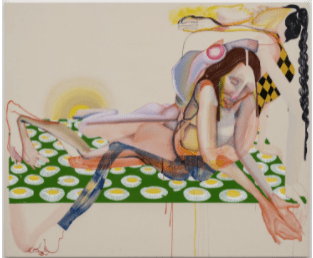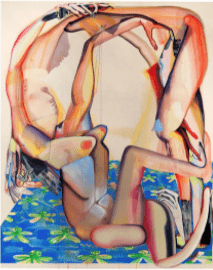JoJo Abell
Intersectionality in Christina Quarles’ Art
Women’s figures and identities in media are, and have been for a long time, mostly portraits of society’s ideals and expectation of what women “should” look and be like; this can be seen in advertisements, movies, tv shows, social media, and so much more. These portraits of women teach us to look at women as objects and look at our own bodies as ugly forms that we need to change to fit the impossible beauty standards set for us. Sexism in society and media is especially directed at LGBTQ+ women (particularly transgender women) and women of color. Some art also objectifies women, but many artists try to upend these expectations. One such artist is Christina Quarles.
Christina Quarles was born in 1985 and she is currently working in Los Angeles. She attended the Yale School of Arts. She is mostly known for her paintings of female figures, though she also does ink drawings of similar forms. Her art is focused on female sexuality and the complicated relationship between ethnicity, ancestry, and the perception of others. As she says on her website christinaquarles.com, “The contradiction of my Black ancestry coupled with my fair skin, results in my place always being my displace. Throughout my paintings, there are perspectival planes that both situate and fragment the bodies they bisect—location becomes dislocation.”
 This can be seen in her acrylic on canvas painting “Feel’d” (2018). Even the title could have more than one meaning. It could mean “field,” because the abstract figures are positioned on a meadow like green shape with flowers, or because of the different planes of space the figures reside in. It could also mean “feeled” as in “felt,” which would make sense with the strange angles of the limbs, the sad expression on one of the faces, the relationship between the two figures in the upper right hand corner, or the overall emotional tone of the painting. The painting contains many dismembered body parts painted in colors ranging from pink to brown to blue that stand out from the green, yellow, and off white background. The limbs are contorted and it is not totally clear which person they belong to, or what part of the body they are. They are almost like objects that are separate from the people, but (unlike in most media) they contain feeling and are not degrading the subjects of the painting. The figures are abstract and do not attempt to depict society’s ideal female body types or positions.
This can be seen in her acrylic on canvas painting “Feel’d” (2018). Even the title could have more than one meaning. It could mean “field,” because the abstract figures are positioned on a meadow like green shape with flowers, or because of the different planes of space the figures reside in. It could also mean “feeled” as in “felt,” which would make sense with the strange angles of the limbs, the sad expression on one of the faces, the relationship between the two figures in the upper right hand corner, or the overall emotional tone of the painting. The painting contains many dismembered body parts painted in colors ranging from pink to brown to blue that stand out from the green, yellow, and off white background. The limbs are contorted and it is not totally clear which person they belong to, or what part of the body they are. They are almost like objects that are separate from the people, but (unlike in most media) they contain feeling and are not degrading the subjects of the painting. The figures are abstract and do not attempt to depict society’s ideal female body types or positions.

In Christina Quarles’ painting “Held Up Thru Yew,” she displays the reliance we place on our own bodies and others. The figures and limbs arearranged in an oval and are literally holding up and balancing each other. By painting the women nude, Christina Quarles’ shows them not as women with the exact current body standards held for women, and she shows female sexuality. The many caressing hands present in the artwork add to this expression of sexuality and queerness. Christina Quarles states “As a queer, cis-woman, born to a black father and a white mother, I engage with the world from a position that is multiply situated,” on her website christinaquarles.com. This idea of seeing the world from multiple perspectives can be seen in her paintings, including “Held Up Thru Yew.” Each piece of the artwork is seen from a different angle, and the subjects of the painting themselves are viewing the scene from different perspectives – because they are placed in distinct positions. The color of the ground mostly is a bright primary blue with some details in a bright shade of green. This allows the orange and red tones of the skin to stand out, though the subjects are grounded the the background with the occasional blue shadow. The shadows are not all created with one light source, which further accentuates the different angles and perspectives of the painting.
Christina Quarles’ paintings are beautiful representations of overlapping themes like race, gender, and sexuality seen in overlapping bodies, limbs, and backgrounds. The colors are vibrant, but not overly so; the colors still blend and compliment each other. The colors also allow the figures to stand out from the ground the figures are placed on. The shapes used are long and graceful, but they are distorted and are not used to show the “perfect” female body that the media so often pushes. The positions of the women in the paintings show openness and confidence in their bodies and themselves. People are deeper and more complicated than their appearance; everyone sees the world differently and we can never truly understand where people are placed in the world.
Sources:
https://www.christinaquarles.com
https://ocula.com/magazine/conversations/christina-quarles/
https://observer.com/2021/04/christina-quarles-interview-art/